#eagle. maybe falcon. but a large bird of prey.
Text
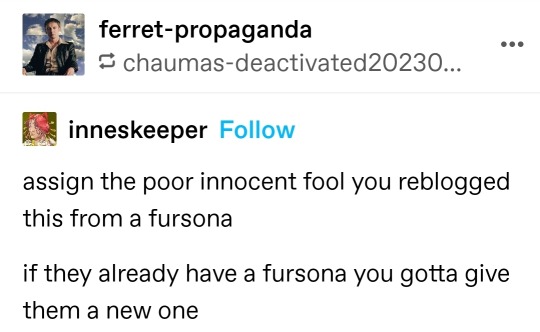




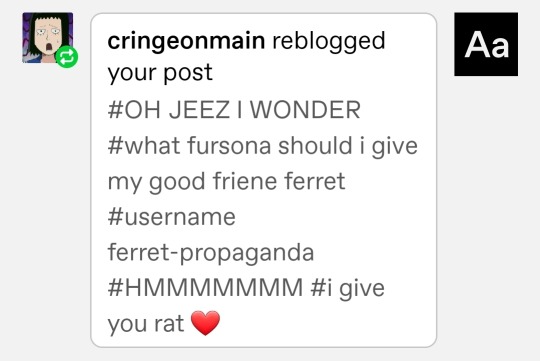
Thanks everypony 💕
#made me giggle#mine#but also yours ❤️#anyway your fursonas are#in order of screenshots#eagle. maybe falcon. but a large bird of prey.#i had a big long think and idk why but either goat or sheep.#and zid if i'm rat you're duck. remember tim stoker with rat and gerry delano with duck? good times
14 notes
·
View notes
Note
How would the brothers react to Branch’s fear of birds? like maybe their out on a walk then a bird just comes sits down by Branch to which Branch screams bloody murder and begins to tremble in fetal position.
First, I don't like how the series presented the phobia of birds, in fact it is called ornithophobia, which is more focused on the fear of large birds, like falcons or eagles, but I think it also applies to birds in general; Anyway, I will say that this story is one that, although it "happened" in the world of Trolls (at least in the series), I will say that Branch uses it as an alibi to hide the real reason why he is afraid of birds.
and I will say that it was because a bird attacked him violently when he was setting one of his traps or collecting food, the bird saw him as an easy prey and attacked him, lifting him into the air where another bird fought to get his "food", like this that Branch was pecked, scratched by claws and bitten (can birds bite too?), they let go of him and he fell from the sky and they caught him again and lifted him up, until Branch managed to attach his hair to a branch and hide in a hole in the tree.
Well, having said that.
The brothers decided to take Branch on a little excursion, of course it was more Branch showing him around to prevent them from getting lost in the forest (Floyd had already gotten lost once and they didn't need that to happen again), everything was fine, it was a sunny day, they were having fun, Bruce was telling a story about when he and Brandy were going out, Branch was laughing at something silly that Bruce did to impress Brandy, when a large shadow passed over them, no one took it into account, too absorbed in seeing his little brother laugh carefree; until she wasn't.
one moment Branch was standing next to Clay, laughing like a child; and the next he was gone, John Dory panicked when he didn't see him, Floyd tried to calm him down, while Bruce and Clay looked for him; Then the shadow passed again and they heard a squawk; Next to that they heard a scared scream, John ran and moved Branch's hair when he saw him; Branch was in the fetal position, the shadow passed again and Branch threw himself at John Dory, hugging his older brother, trembling with fear.
"It's a bird," Clay reported, looking at the sky, he looked again at Branch who was trembling in John's arms, Floyd realized that what scared Branch was the bird.
They had to go back to the bunker, Branch was a nervous wreck and was terrified, Floyd stayed behind while John was in charge of calming Branch down, Floyd looked at the bird, he just wanted to shoot down that feathered creature to take away his little brother's fear.
#trolls#trolls band together#brozone#trolls brozone#trolls branch#trolls john dory#trolls bruce#trolls clay#trolls floyd#beloved little brother#possessive brozone#possessive
72 notes
·
View notes
Text
I read this amazing Cody-centric wing-fic by @meebles, so now I'm thinking about Clones with wings, and - because I'm me - specifically the Bad Batch with wings.
What would their wings look like? The regs' wings would all be identical/very similar, of course, with the individuality mostly showing in dyes and so on. But the Batch with their mutations will likely have different wings too.
I want Crosshair's wings to be similar to the ice vultures', for obvious thematic reasons, but also because vultures tend to hang around in high places, whether that's sitting in a tree somewhere or circling high up in the air, waiting and watching. Good sniper traits. I don't think we really get to see the vultures in the show, but I assume they're white/grey, to blend in against the snow and ice and white/grey skies. Good colors for Crosshair.
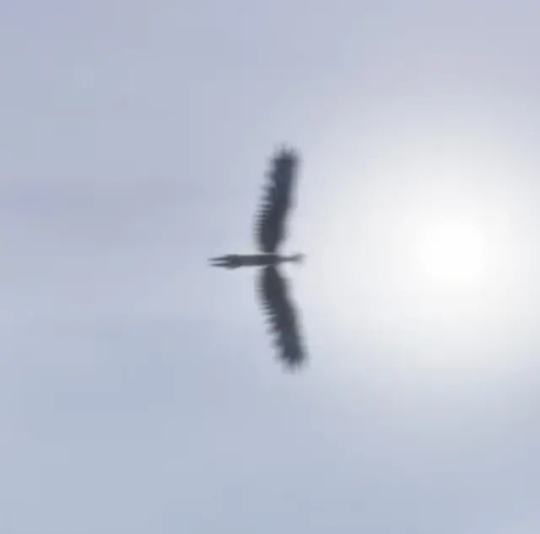
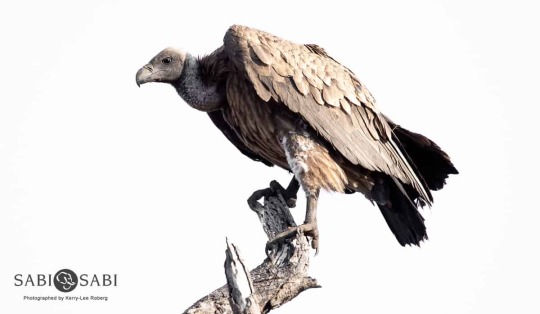
The rest will be under the cut because this got away from me a little (a lot).
For Tech, I'm thinking common kestrel wings. I don't know if kestrels have any particular behavioral traits that would fit Tech, I mostly just like their colors for him. I did read a little bit, though, and what stood out to me was that the kestrel has multiple hunting methods - it does the usual bird of prey thing, of circling around on an updraft over open land and diving for its prey, or sitting on a fence pole or in a tree or even a bush and jumping on a mouse or whatever that gets too close. The thing it does that's maybe less common is that it will also skim across fields, very close to the ground, to pounce on anything small enough for it to eat. And maybe I'm reaching a little here, but that seems to me like a very resourceful bird which is also a very competent flier, and I figure that does fit our Tech very nicely.
I do kind of want to pick vulture for Tech too, if just to match his twin, but. I like the kestrel better. I mean, just look at it:
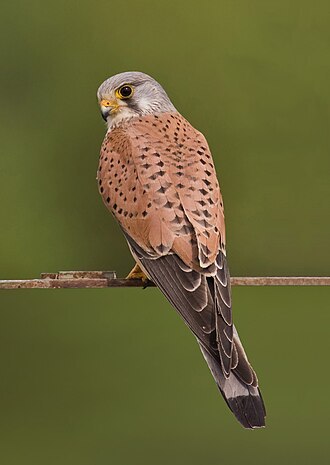
For Wrecker... Maybe something like a white-tailed eagle? Because. Big. And good at fishing. On a more angsty note, I'm thinking whatever happened to give Wrecker his iconic scar/cost him his eye, it probably also damaged his left wing. Maybe not enough to ground him fully, but enough that flying/steering would be harder for him, which is at least part of the reason he's still scared of heights.

Hunter's wings would probably be pretty similar to the regs', maybe a tiny bit smaller. I'm thinking something like the New Zealand falcon, or kārearea. Bird of prey, dark brown, fairly simple coloring (though still very pretty). According to the NZ Department of Conservation, there are three ecological forms of the kārearea: A large, pale 'eastern' falcon; a smaller, darker 'Bush' falcon, and a 'southern' falcon that's somewhere inbetween in both size and color. Perhaps the regs' wings are more like the eastern/southern ones (left image, I think), while Hunter's are more like those of the bush falcon (right image)?


Disclaimer: I actually know fuck-all about these birds, only what I've just read - if I'm mistaken about the identity of these birds, I blame the sources, which should all be linked in the images, though tumblr is tumblr.
Echo doesn't get his own picture (sorry, Echo) because he's a reg, technically, so he has wings like the left one above. I... am not sure what happened to them in that explosion, or his time on Skako Minor. Probably not very good things. Maybe his wings are just heavily scarred/damaged, maybe they're gone completely. Maybe he's got prosthetics for one or both of them?
(I'm just now realizing that the Clones having wings would mean some things on that mission to Skako Minor - namely, the escape from the techno Union's facility - would turn out slightly different, since they don't need those flying reptiles to get away when they have their own wings. Though maybe they still do if at least one (Skywalker), and maybe two or three of the people on that team can't fly (Echo, Wrecker). I'm well aware them having wings would completely change the mission to Eriadu in the TBB s2 finale, what with them being able to just. fly over there. and away again. Even if they do use the sky-rail or whatever, for Wrecker and/or Echo's sake, Tech would still have his wings, so... All's good.)
Omega also doesn't get her own image (sorry, Omega) because while she's not a reg, exactly, she's an unaltered Clone, which means... Well. I'm not actually sure what that means. I suppose that depends on whether Fett had wings, or that's something the Kaminoan's added? I'm gonna go with the first one, because I like that better. The Kaminoans may have changed things about the wings, but Omega will still have wings, because Fett did too. But that also means she'll have wings identical, or at least very similar to the regs' (left img. above), though maybe she'll have lighter feathers, to match her lighter hair. Also, since she's still (physically) a child, she'll have wings that look more like the immature/juvenile falcons', which means... less spots and stripes? I think? I'm not sure.
I'm also not sure when this whole thing changed from 'idle musings' to 'full-blown headcanons' but it certainly happened. Let me just go back and add a read-more somewhere. Alright, that's done. I'm not really sure if I'm actually gonna... do anything with these headcanons. I do really like the concept of meebles' fic, though - showing different relationships through the grooming and preening of wings - so maybe I'll write something a la that at some point, just for the Batch instead of Cody. Maybe some hurt/comfort about what the Empire does to Crosshair's wings while he's a prisoner? And how he has to learn to trust people near him/his wings again, and how his brothers help him heal, both physically and mentally.
If I do ever write something about all this, I'll make sure to link back to meebles's fic as the inspiration - and in case you missed it up top, or just don't wanna scroll all the way back up again (that's fair, this got rather long), here it is again: and the stars, like a loved one by firelord_zutara on Ao3, also known as meebles here on tumblr. Go read it, you won't regret it.
#Star Wars#codywan fic rec#Star Wars: The Bad Batch#TBB headcanons#TBB wings au#Clones with wings au#TBB Crosshair#TBB Hunter#TBB Wrecker#TBB Tech#TBB Omega#Clone Trooper Echo#birds#birds of prey#to the people still waiting for me to answer their WIP Wednesday ask: I'm sorry; I promise I will get to them#words are just annoying atm#I say; having just written how many words about clones and birds and bird-clones? idk I'm not counting them#if there are any mistakes in here I'm sorry but its 1am and I'm very tired so I'm gonna go to bed now#enjoy?
14 notes
·
View notes
Note
hi there! if you are still doing daemon form finding, i wonder if you could help me? i've taken the test so many times and somehow it feels as if it never fully encompasses me, you know? perhaps a lack of self-awareness could also be at fault, ha. i’m a intj, 8w9 & slytherin. on the aura quiz, crimson. deeply passionate, intuitive, really love forming connections and am incredibly good at understanding others (which if kind of funny considering it in no ways apply to me), but a bit ferocious.
ooo an INTJ 8, no wonder you're having difficulty finding a form! very take charge, independent, and ambitious, you're definitely going to be looking at something perceptive and ferocious.
i feel like i've been suggesting birds of prey a lot, but i do think they'd be an apt pick for you. species that match the INTJ's ingenuity and drive for efficiency would be most fitting, maybe along the lines of falcons? falcons are decisive, assertive, and capable; they can be shrewd and cutthroat, and they process things in a detail-oriented and logical fashion. they have high standards for their projects as well as others and they don't sugarcoat things — they know how to get what they want, so while i do think they are capable of being intuitive considering how loyal they are, they are likely pretty critical and honest most of the time. i've been picking through the falco genus and there's quite a few options. kestrels and hobbies seem like they would fit you really well, though i was really drawn to the sooty falcon for you as it displays some strong inventiveness and cooperative in its hunting. the aplomado falcon is also an incredibly admirable bird and frequently used for hunting if you're someone who really prides yourself on your intensity and observational skills.
aside from falcons, large owls might actually be a pretty good fit for you, ones that are apex predators. the snowy owl, great-horned owl, and eurasian eagle-owl are great starting places. the owl form is going to be more enduring and privately confident than the falcon, perhaps more defensive than straight up assertive. this isn't to say they aren't extremely hardy, ambitious, and determined people. they also have a high sense of loyalty to both their loved ones and their routines and will tend to be less adaptable and spontaneous. they'd also be less cooperative as well, though still quite intuitive and inclined to follow a pattern once they suss out all the options and find something that works for them. the powerful owl is also a pretty cool form that's a little more bold and purposeful.
heading into mammals, my first thought was a territorial bear species like the polar bear. they're internal and hardy, though also known to be a rather inquisitive and playful animal. while independent and preferring not to be tied down, they're socially aware and the types of people happy with just one or two close friendships that endure over their lifetime. the polar bear's unique biome makes this form exceptionally inventive, efficient, and competitive. it therefore follows that the polar bear soul is going to be similar: shrewd and ruthless when it comes to taking up space and achieving their needs. one caveat is that bear forms tend to be more on the unambitious and lazy side; even for the polar bear, they're going to live according to their own schedule and tend to have an inconsistent work ethic. you i also might consider a more urban wild cat like the cougar, who would be an exceptionally confident and adaptable individual. very driven and perceptive, though as a wild cat tends to be pretty self-focused and guarded.
and finally i wonder if you'd gravitate at all towards reptiles? reptiles are pretty much the classic INTJ 8/9 for me, especially crocodilians. they're actually fairly tolerant socially, and while not the most affectionate, they tend to be loosely loyal and surround themselves with people they know have similar values or at the very least don't irritate them. reptile forms are going to be highly, highly perceptive. they may come across as less individualistic, but it's mainly because they prefer to assess situations before they take action. they're cunning and capable of being manipulative; crocodilians in particular are very assertive, though they're logical people and careful about expending their energy. off the cuff, the american alligator seems like it could fit you. socially they're pretty chill and tolerant, even loyal with those they've come to appreciate, though they very readily will communicate their thoughts and boundaries to others. they're extremely passionate at heart, even if they tend to have more of an inexpressive, unapproachable reputation — they like being able to succeed in any environment, and while their work ethic is more of the "slow and steady" kind of style, they're highly persistent and inventive. the nile crocodile could also work if you're more ambitious and determined, as well as willing to be cooperative. caimans are also a great option as they're independent but highly intuitive, respectful, and observant.
hope this helps! :)
6 notes
·
View notes
Note
Just gonna leave this here: a quirk that turns Hawks into an actual hawk version of himself that can talk, and his poor s/o must be his falconer until the quirk wears off. Alternatively, Dabi getting chibi’d. MANY LOLS TO BE HAD. And also burnt pants pockets, if I’m not mistaken.
If Hawks was a bird, I’d imagine his appearance would resemble a Brahminy Kite aka red-backed sea eagle. Yeah, I know they’re not exactly hawks but it’s such a perfect look for him. Though I’d imagine his front plumage to look more blonde than white.

The news reporters were already swarming him. At least give him a chance to breathe; this was probably more shocking to himself than it was to them. It’s also just a little intimidating to have so many people several times his height squatting down and shoving mics into his little beak.
“Did you see the villain that did this to you, Hawks?”
“How long will this quirk last?”
“Will you be able to carry on with hero work in this condition?”
“What do you have to say to your fangirls right now?”
“Would you be willing to have a photoshoot with us and promote our bird shop?”
He raises his wings (man, it’s weird when they’re your only upper limbs) and attempts to calm everyone down.
“Relax, everyone. I’ll have this all fixed up soon, I promise! And don’t think I’ll be taking a break from hero work just because I’m small enough to perch on your arm. You villains out there better stay put!”
The flashing cameras hurt. His eyes felt more sensitive than ever.
Of course, that was a bit of a lie. Hell no, he isn’t fighting any competent villain while he’s a literal bird, but he already knows that the Hero Commission isn’t going to let him sit back even while he looks like this.
-----------------
What the fuck were you watching.
A group of reporters were crowding a bird that had just hopped out of your lover’s hero outfit which was piled on the floor. And they were calling the bird Hawks.
And then the bird spoke. With Hawks’s voice.
No way.
A bit less than an hour after those surreal interviews, a rapping sound was heard at your window. Lo and behold, the same bird you’ve been looking at all over the Tweeter feed was waving at you as he waited patiently to be let in.
You didn’t know where to even start as he waddled in, unsteady on legs that bended in ways he wasn’t used to, and large talons that scratched every surface.
“Did ya miss me, baby bird?” Wow, he really just used his seductive voice.
Your discussion with him about what he plans to do while in his current form is as awkward as you expected, with one extra curve-ball thrown in.
Your face looms over his smaller head. “What do you mean you need me on your patrols? Patrols that you shouldn’t even be doing right now?”
He shakes and puffs up his feathers. “You’ll be my partner in crime! Well, more like you’ll be the one carrying my goods around and answering calls while I take down bad guys. And I have to make sure I always have a good takeoff spot, since I’m not as quick and limber of a flyer as I usually am. It’ll be safe, I promise.”
-----------------
It wasn’t very safe.
Sneaking up on a villain in a sketchy ally was not safe at all. Hawks was unknowingly digging his talons into your skin as he kept his body low, his wings only half-folded in case he needed to fly at any moment.
With a signaling squeeze (ouch), you swung your arm as he leapt off and flew toward the unassuming criminal.
It was...ridiculous, watching what was an intimidating man make high-pitched yelps of surprise and swat at the hawk flapping around his head. All respect as a villain is probably lost if you’re subdued by a bird that isn’t even half your size.
“Now!” Hawks shouted while he had the man’s arms pinned behind his back.
You rushed in to click the handcuffs around his wrists.
“That’s your third arrest, baby bird! You oughta try for a hero license!” He praised you with a wink.
“Thanks, but I’d rather have this entire fever dream end as soon as possible.”
His phone vibrated in your pocket and you withdrew it to see which sidekick or Commission member was calling him this time. Instead, a strange name popped up.
“Who is...‘Burnt Bitch’?”
Hawks swooped in and snatched the phone out of your hands before you could even blink.
“Aheheheh, sorry love! This is a personal call that I gotta take myself!” He flew out of your sight, leaving you to handle the humiliated and angry villain by yourself.
-----------------
Hawks swore when he scratched his screen as he attempted to answer the call. Dammit, Dabi sure was a master of contacting him at inconvenient times.
Having finally pressed the button, he gave his usual greeting to the fiery villain. “What’s up, Dabs?”
“So you’re a literal birdbrain right now, are you? Pretty hilarious.”
That...was not Dabi’s voice.
“Um, why do you sound like a chipmunk?”
“...I’m just using a voice changer,” the squeaky villain said. “I shouldn’t make myself too obvious when talking to you.”
Hawks scratched his head, flinching when he nearly poked his eye. “You’re just now deciding to do that, and you couldn’t pick a voice that I’d actually take seriously?”
“Like you’re one to talk. I’m impressed you managed to answer the phone without any hands. You’re meeting up with me at the usual spot tonight.”
“...Tonight?”
Dabi groaned, which sounded more like those low meows that angry cats do. “Did I stutter? Those holes in your bird head work, right? And you better not laugh when you get here.”
Click.
Hawks’s inner eyelids blinked rapidly at the phone. What would he laugh about?
-----------------
Oh.
That’s what.
Hawks rested on a trash can as he watched Dabi emerge from the shadows behind the abandoned building. He was pretty far away, his form slowly getting bigger as he got closer. Although...Hawks is pretty sure that he should look a lot bigger from that distance. Maybe the angle of his giant eyes was screwing up his depth perception.
It was only when Dabi was right in front of him did Hawks realize that the villain was the size of a toddler.
He tried not to let any laughter slip past his beak, and failed miserably.
“What did I fucking tell you?” Dabi growled in his helium voice. Oh god he wasn’t using a voice changer on the phone.
That made the bird hero laugh even harder, wings outstretched as he tried to keep his balance. “Wh-wha...” He struggled to speak between wheezes. “What the hell happened?”
Dabi shuffled in his kiddie hoodie. “Some dumbass thug thought it would be funny to chibify me. I thought it would be funny to turn him into ash, so I did.”
“Really? Do you know if it wears off overtime or did you just kill the poor guy without asking questions?”
“......”
“Holy shit!” Another fit of squawking laughter. “You might be adorable forever!”
A blue flame appeared in his tiny baby hands oh my god he’s so cute!
“Unlike you, I can still use my quirk, so keep talking if you want to become the fried chicken you love so much.”
"You-” Cough. “You don’t even need your fire.” Hawks's feathers were fully fluffed out as he tried to breathe. “If you keep talking with that high voice, I’m gonna keel over!”
A tiny scarred hand around his neck finally silenced him with a startled screech.
“You tweety little bastard.”
Hawks cracked up again as he choked.
-----------------
Shouta Aizawa has come across many strange sights during his late night patrols. Some of them gruesome, some of them obscene, and some that are just too weird to even be questioned.
Finding a child concealed in an oversized hoodie in a bout of fisticuffs with a bird of prey was in the third category.
He couldn’t even tell who was winning. The kid would sometimes get a hold of the bird for no more than a few seconds before a sharp beak digs into his hand and forces him to let go. It was the strangest wrestle that the underground hero had ever witnessed.
“Aww, try again, little baby! You almost had me that time!”
Wait a minute. That voice...
Right, Hawks was still doing work even though he was a damn actual hawk. Well, he probably doesn’t need his help with an unruly brat.
Aizawa walked away from the scuffle and continued his scouting. There are real dangers out here that need to be taken care of.
198 notes
·
View notes
Text
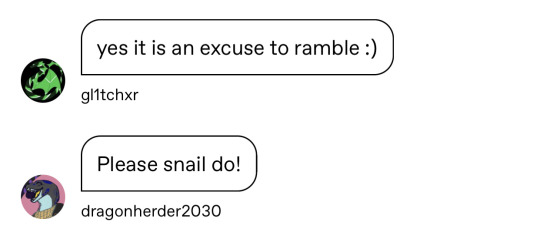
@dragonherder2030 @gl1tchxr
Decided to make this it’s own post but here’s the Lore stuff(previous posts: first, second).
Okay so basic world stuff before I get to characters-
This is kind of like your classical children’s book/movie/show, animals that have relations closer to human like ones and all talk and stuff. But darker! So yeah, warnings for mentions of death, hunting, and just some darker themes.
The animals mostly live in groups, usually mixed between similar species, though some completely only one species, and others are very spread out.
For example, a group of birds of prey consists of falcons, hawks, eagles, and the like. This group would probably be rather large and well known.
The next down, a group of different kinds of hawks, some are red-tailed hawks, some are goshawks or broad-winged hawks. Also probably well known, maybe a little smaller though
And next would be, say, a group of only Red-tailed hawks for example. These kinds are very rare, and 90% of the time are just families living by themselves for a bit, before rejoining another group.
Most of these groups, minus the third example, are lead by representatives of their species.
Representatives are about what they sound, there a single person that represents their species. There’s one for each general species(I’ll get into the specifics of what that means in a moment), and they’re kind of the judge, jury, and executioners of this world. They, of course, have to lead their people this way, but they also have to keep each other in check. If a representative is considered too far beyond redemption, they’ll be cast out by the others, and since the representatives represent their species, the rest of the species will also be outcast.
Representatives are chosen through death, in one of two ways. You see, representatives cannot die of old age, starvation, illness, or the like, their magically protected. They can only die from wounds/in battle, which is how the next representative is chosen. If defeated by another member of their own species, that animal well become the new representative. However, can choose an heir to replace them if they die by another species hand, though that rarely happens. In that case their heir is made the next representative, if this happens and they don’t have an heir the next representative will be random.
So, general species is a very vague phrase, so I’m gonna try and clear that a little. When I say general species I mean, for example, rather then just say Canine, there are foxes, wolves, coyotes, and many others. Rather then just say bird, or uh, song bird or flightless bird, I’d say there’s one secretary bird representative, one finch, one sparrow, one hawk, one kite.
However you wouldn’t specify past the that, for example, there’d be hyena representative, but not one specifically for, say, brown Hyena’s. A brown hyena *could* be the hyena representative, but it would be for all hyenas not just other brown hyenas. I hope that makes sense.
There are some animals where it’s kind of a gray zone, for example like how there are animals called leopards but aren’t actually leopards(snow leopard, clouded leopards, etc.), and in that case… yeah I’m just gonna look at the species a little and pick myself, not exactly perfect but that’s what we’re going with.
Okay now onto some of the other lore stuff, gosh this is already so long.
So ferals. As I mentioned before, some entire species have been outcast before(it’s pretty rare though), but what does that mean exactly? Well in this world when a representative fails their job and species so badly the entire world doesn’t want them, they’re species loses what makes them… more complex, what allows them to talk, and have more ‘human’ characteristics. They become wild animals, in the sense that we see them in the real world, if not worse because it also raises their aggression a bit.
Yeah I know, I never promised this animal world was well run. In fact I made it kind of badly run on purpose. Flawssss like blaming everyone for one persons mistake. Wonderful.
So, a feral animal *can*, technically still retain their more complex aspects, in certain cases, being the exiled representative, for example(because they still retain their near immortality and magic protection till they die). The other way, is if they have a non-feral animals soul. It’s possible for certain animals to trap souls in objects, and give them to people. If given to a feral animal, the feral animal regains their own mind, but can only speak in the voice of the dead animal.
Okay so there’s all that out of the way, let’s talk some more about relations. (Tw for talk about eating animals/hunting(by other animals of course) until the part that says ‘okay let’s move on from the dark stuff’)
So there are still, of course, predators in the world who can only eat meat. They’re usually given this through those who pass away from other means(old age, injury, or other such examples), however there are other cases. If there’s an actual battle between two or more groups(started for reasons other then food), or in special zones.
These zones are taught to all from a young age, and most people avoid them, however they are widely accepted as violence/hunting zones. Basically places where most rules don’t apply, and animals could be hunted/attacked/killed without much repercussion. These zones also work in reverse tho, because they’re sometimes used for groups of smaller animals to gang up on bigger ones without facing whole groups of bigger ones(they’d take one at a time). Oh and feral animals are always allowed to be attacked/fought/hunted on sight. They have no protection.
Okay let’s move on from the dark stuff! Interspecies relations,
So as I said, it’s not uncommon to see, say, different kinds of birds of prey together, it also wouldn’t be uncommon for birds in general to be grouped, usually in a settlement in that case.
You could probably see a bunch of aquatic mammals and reptiles sharing gossip and a snack on popular beaches.
A group of iguanas protecting a group of smaller newts and geckos.
But what about, crossing even the similar species bound? Seeing a jackal and a crocodile together, not as enemies but as friends? Very rare but not unheard of.
The most common, but not only, case of un-alike species being together is traveling. Two animals who are traveling alone/separated from their group, and have destinations close to each other. They may want extra protection, or just company. This is usually only 2, 3, or 4 animals. Bigger groups haven’t really been seen, but they probably exist lol.
Otherwise, they’ll be seen in settlements. Sometimes a group of, for example, aardwolves and actual wolves may settle, but they didn’t know really close by was a settlement of tigers. The two groups meet and happen to get along, their technically separate still, but they work together and live so close to one another a visiter may assume their one settlement.
And uh.
This is most, though not all, of the the kind of the world building stuff! Hope you like it, sorry for talking so long wheuduhfhsha.
I may make a other post talking about the story and characters specifically, but this was just the basis
OH ALSO. Most of the examples for relations I just made up on the spot and aren’t cannon, they *could* be, like there could be a jackal and croc friendship I make in the future, but most of them are just random things I came up with. That’s all.
As always questions/comments are encouraged because they help me improve and add onto the lore, and also help motivate me to work, lol.
#snails meta#rambles#talk#long post#tw: death mention#tw long post#tw animals eating other animals#animal ocs
7 notes
·
View notes
Note
“hey, jay! i was wondering…. do you maybe possibly perhaps have any pets? that i could pet? and if you don’t, what are some pets that you’d like to have?” - kat
(This took way longer than it should have)
"Hey, Kat! Pets, huh? Well... I don't really have any pets. I can barely keep myself alive, heh. I do know this one rat that hangs around the castle... I call him Ramsey. You can certainly try and pet 'im if you can find him, he likes to hang out in my pocket. As for pets I'd want to have... large birds of prey. Owls, Hawks, Falcons, but Eagles... hoo, eagles are a whole 'nother level. A Golden Eagle, the ones they use fer huntin'. I tried to get Talbott to land on my arm a few times, but… turns out he didn’t like that.”
1 note
·
View note
Photo

Lit by early-morning sunshine, the country lane ahead of me is enchanting.
One side is hedge, sweetly fragrant with white hawthorn blossom, and the other, old dry-stone wall, covered in emerald moss, moist and springy to the touch. Every now and then a wren darts in and out of the wall, looking for the perfect space to nest-build. On the ground, life is also starting to fizz. Fresh, tender shoots are emerging. The broad dark-green leaves of foxgloves spread themselves out and a pair of golden brimstone butterflies flutter around the mauve petals of common dog violets.
A misty valley in Borrowdale in the Lake District National Park
I stop for a moment and take a slow, deep breath –thankful to be back in Lake District National Park in North West England. It’s not just me that finds these landscapes so irresistible. Just over 114 kilometres from the thriving metropolis of Manchester, Lake District National Park, at around 2,362km2, is England’s largest, and more than 19 million people from all the over globe visit it annually. Just like me, visitors here are thrilled not just by the region’s spectacular scenery, but also by the rare creatures that live in its ancient oakwoods and the birds of prey that majestically soar the skies.
At springtime, the Lakes – as the area is better known – are especially magical, but it’s a place that beguiles at any time of the year. The otherworldly beauty of its windswept mountaintops, dramatic valleys criss-crossed with idyllic country lanes, sparkling waterfalls and deep, clear lakes often haunts me long after I return home.
Path from Stonethwaite to Rosthwaite
But of all the region’s valleys, it’s Borrowdale that casts the strongest spell on me. The picturesque area, which is situated in the green heart of the Lake District, is a haven for some of Britain’s most endangered flora and fauna. It’s where I am now, and the country lane I’m passing through is in the small village of Rosthwaite, some nine kilometres south of Keswick, the valley’s main town. This is the start of one of my favourite walks, which will take me through a myriad of arresting landscapes, from craggy fells to wild moors, from mountain tarns to oakwoods and, finally, from river valley to lakeshore. It’s a beautiful microcosm of all that the Lake District has to offer.
Borrowdale has thrilled me since childhood. A huge, wild, living playground, it was the perfect antidote to the grey shades and straight lines of school and suburbia. With my parents, brother and sister – as well as our dogs, a young and exuberant Irish wolfhound and a sensible, much older border collie – many happy summer days were spent here. In the meadows, we searched for daisies, buttercups and forget-me-nots for my flower press. And, in the woods, with socks and shoes off , we chased each other around huge oak trees, picking up acorns, throwing them for the dogs to catch, always saving a few to play wonky marbles with later. Then we’d find a clear stream to cool down and clean our hot little feet before starting our adventures all over again.
A ram near Watendlath
Of course, some four decades on since playing in the woods here, it’s sturdy boots, rather than bare feet, for me on my walk today. Now reaching the end of the lane, the view opens out and my climb up Great Crag, a steep fell-side, begins. The colours are different here – less verdant, more of an autumnal palette of faded-purple heather, burnt-brown bracken and grey rocky knolls. The colour of storm clouds. Now, some 200 metres above sea level, I turn around and marvel at the classic Lakes view. The valley floor – which in the summer months is ablaze with wildflowers – is strikingly green, intersected by the shimmer of the River Derwent that snakes through Borrowdale like a silver ribbon.
Turning back towards Great Crag, I follow the bridleway until a large whitewashed farmhouse and a small cluster of stone cottages come into view. This is the secluded picturesque hamlet of Watendlath that nestles on the shores of the tarn here. Apart from a mewing buzzard above me, enjoying the warm thermals, and a gaggle of honking barnacle geese, it’s incredibly quiet.
A blackbird on a wall near Stonethwaite
I take the path around the water’s edge, passing a flock of free-roaming sheep. Huge moss-covered oaks, with branches outstretched like arms and twigs pointing like fingers, cast their shadows. As the terrain turns to moorland, damp and peaty in places, I spy the yellow-green heads of bog myrtle popping above the scrub.
I scan the sky, hoping for a sight of another buzzard or maybe a falcon. It is empty. If I’d been standing here three or four years ago, though, I might have seen England’s last golden eagle, known as Eddie, filling the void. Up until the early 1800s, golden eagles – Britain’s second-largest bird of prey with a wingspan of around 1.8 metres – were numerous in the Lakes. But regarded as a threat to new-born lambs, the birds’ eyries (nests) were systemically destroyed by local sheep farmers – causing such a catastrophic decline in their numbers that golden eagles became locally extinct by the 1850s.
A pair of keen ramblers taking in the scenery
Since then, only very occasional pairs have settled in the Lakes. The last known couple were Eddie and his mate. He is believed to have died in 2016, some 12 years after the female. Fortunately, conservation measures have been put in place to encourage the return of these iconic birds. It’s hoped that chicks from successful populations in southern Scotland will be introduced here soon, turning the Lakes’ skies golden once again.
“Rare creatures live in its ancient oakwoods and birds of prey majestically soar the skies”
After two and half kilometres or so, I see Dock Tarn, one of the Lake District’s most beautiful mountain lakes. Circled by a small ring of tor-topped hills, covered in heather and bilberry, the tarn is aglow in the sunshine. On the surface, some yet-to-flower waterlilies shiver slightly as a light breeze brushes over them. Come high summer, orchids can be found among the grasses, and when the heather blooms, the tarn will reflect their hazy-purple hues, as if in perpetual twilight. It’s not just Dock Tarn that mesmerises. From here, I can also admire the summit of Glaramara and enjoy take-your-breath-away views of other mighty fells, including Haystacks, Honister and Pillar.
An arresting view of Derwentwater as seen from Catbells fell
The Lake District’s natural beauty has quickened people’s hearts for centuries. During the 1800s, some of England’s best-known Romantic poets and writers – including William and Dorothy Wordsworth, Samuel Coleridge, Thomas de Quincey and John Ruskin – were particularly enamoured. They celebrated the Lake District’s sublime beauty in their writings, often elevating the region to a heaven on earth, a wild Eden where man could achieve spiritual harmony with nature. William Wordsworth – probably the most famous Lakes poet, and author of the love song to the Lakes “I Wandered Lonely as a Cloud” – in his great autobiographical work The Prelude, published in 1850, described the region as a place where:
“The solid Mountains were as bright as clouds,
Grain-tinctured, drench’d in empyrean light;
And, in the meadows and the lower grounds,
Was all the sweetness of a common dawn,
Dews, vapours, and the melody of birds,
And Labourers going forth into the fields.”
A bridge in Rydal
Turning away from the “bright as clouds” view of the summits, I trace a stone-pitched track to the hanging oakwood at Lingy End and begin my descent. The climb down through the ancient wood is steep, and I’m kept company by the babbling Willygrass Gill stream. Originating at Dock Tarn, it cascades gently down the valley, eventually joining the River Derwent. Shoots of pungent wild garlic sprout between rocks and stones, joined by butter-yellow, star-shaped celandine flowers.
“A wonderland I first visited as a girl, I am lured back to the Lake District year after year”
I scan the trees for red squirrels, an endangered native species. Thanks to special conservation programmes, Borrowdale’s woods are one of the best places in England to spot this rare and elusive creature. I also look out for red and roe deer, but as with the squirrels, I am out of luck. I do, though, sight a great spotted woodpecker drilling into a tree, its distinctive black, white and red markings glimmering softly in the dappled light.
A cottage in Stonethwaite
Borrowdale’s oakwoods are the remnants of the temperate “rainforests” that once flourished on the western seaboard of Britain. They are the precious last habitat of disappearing moss and liverwort species and support an incredible variety of ferns and fungi, as well as butterflies, moths and other insects. That’s why Borrowdale’s oakwoods – over 500 hectares, home to more than a hundred bird species – are afforded the highest tier of protection available to habitats in Europe.
After an hour or so, the steepness of the slope eases and I’m back on level ground in the village of Stonethwaite, just next door to Rosthwaite. The wide walled and pretty path here runs parallel to the River Derwent, considered one of the purest rivers in Europe. Freshwater shrimp, lamprey and salmon thrive in its protected waters – even sleek-haired otters, once locally extinct, are back and can sometimes be spotted on the riverbanks with freshly caught fish in their paws.
Two people fishing at a reservoir in Watendlath
Back at Rosthwaite, I jump on a bus and less than 10 minutes later find myself on the shores of Derwentwater, one of the Lake District’s fi nest glacial lakes. In the afternoon light, the water reflects the shape of the mountains that circle it. A swan glides by, heading towards Lord’s Island, one of the lake’s four main islands. Once inhabited by the Earls of Derwentwater, the island is now a desirable residence for nesting birds and primroses only. During the winter months, the secluded bays and headlands here provide shelter for many wildfowl, including greylag geese, mallards and moorhens.
The Queen of the Lakes, as Derwentwater is also known, is the only place in England – apart from Bassenthwaite Lake about 16 kilometres further north – where vendace, a rare Arctic fi sh species dating back to the Ice Age, survives. Bassenthwaite Lake is also the place to see the Lake District’s only ospreys. These spectacular birds of prey, with a wingspan of almost 1.5 metres, returned to breed in 2001, after an absence of almost 150 years, and during the summer months can be seen diving for fish in Bassenthwaite’s pristine waters.
A river scene in Rydal
Two years ago, in 2017, the Lake District National Park was designated a Unesco World Heritage site. It became a National Park in 1951, one of the first established in Britain after the passing of the 1949 Act of Parliament. This year marks the 70th anniversary of that Act, without which the UK wouldn’t have its 15 glorious National Parks to explore and enjoy today.
That the Lake District is – and remains – a protected place is important to me. The Lake District is a gift. A green refuge where once-lost species have returned; a precious jewel of a place where I, and countless others before me, have felt at peace and been inspired, and found gentle reminders of a more natural past. A wonderland I first visited as a girl, I am lured back to the Lake District year after year. And each time I return, I fall back in love – bewitched all over again by the “empyrean light” of the Lakes that shines forever bright, captivates completely and re-wilds my heart.
SEE ALSO: Why Manchester is the UK’s next creative powerhouse
This article was originally published in the June 2019 issue of SilverKris magazine
The post Over vales and hills: The enchantment of the Lake District appeared first on SilverKris.
2 notes
·
View notes
Photo


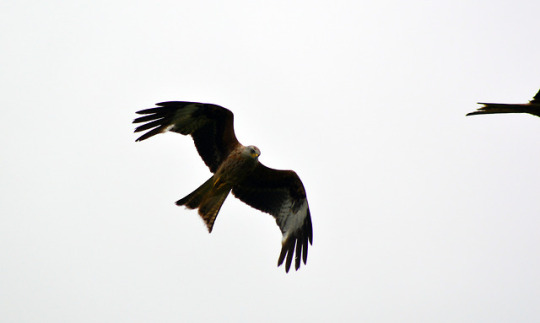
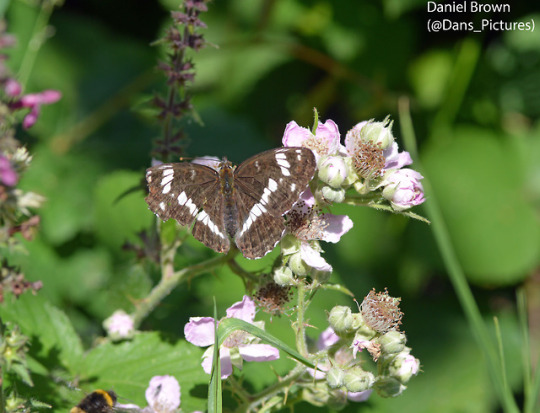

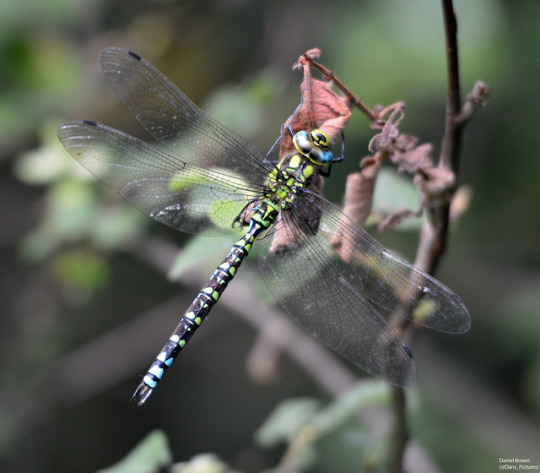

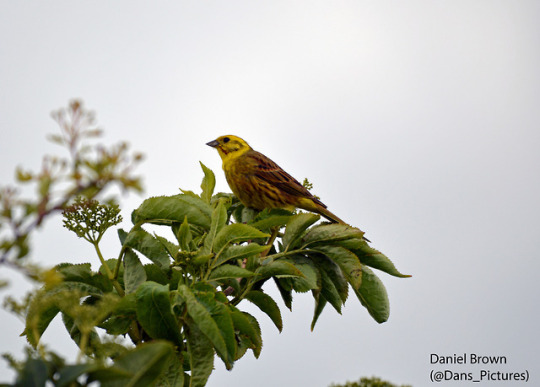
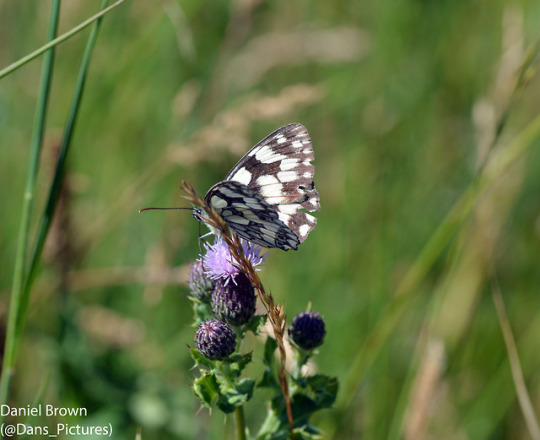
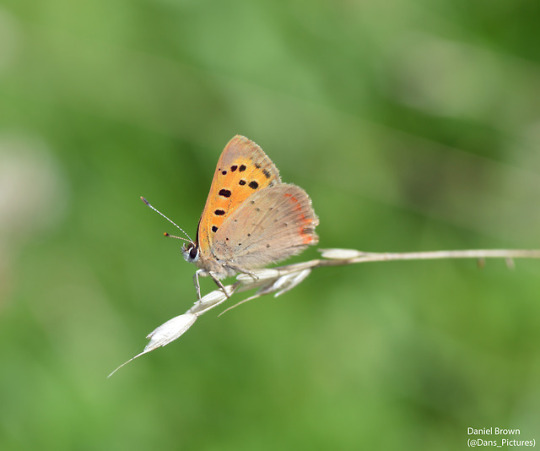
Additions to my lists of favourite birds and butterflies and creation of B lists of them
This morning I had a long overdue sort of my lists of my favourite birds, butterflies as well as mammals and dragonflies and damselflies to a lesser extent. As some of you may know I have a long list of favourite birds and butterflies especially as I always find it hard to just pick one favourite and over the years of my hobby many species have been so precious to me. Since 2015 when I last added to my list of favourite birds I tried to be strict with adding any.
However over those years and especially in the last few weeks I have felt there were a few species I had began to really love deeper and wondered whether it might be time to start calling them a favourite bird of mine. The same really happened with butterflies.
I first considered during my long think this morning do I want to carry on with these lists or just disband my list of favourites and let it flow a bit more. But I came to the conclusion that calling something a favourite of mine is still the most simple way to express the ultimate form of how good I feel about it, and at the heart of my hobby as much as anything is the fact that I really like keeping lists.
In every walk of life really I have many favourites of things. Things like my favourite football player or my favourite food for example are things I might not want a strict list of, my favourite football player tends to change a bit and is probably always gonna play for my (one and only) team. My favourite food I don’t really care enough to enter it onto a spreadsheet. But with the species of animals within my main hobby I obviously do care so much and its quite geeky but I like to have it all organised and ordered so I still need my lists of favourites I thought. I may not do it as much in future who knows but for now I am committed to it.
So I listed birds and butterflies I have had those feelings for and put them through a little competition where I scored them on particular criteria. From this I added three birds to my list of favourite brids to make that 27, two to my list of favourite butterflies to make it 11, one dragonfly to make it 6 favourite dragonfly and damselfly species I have and I kept mammals at 8 favourites as I felt there were no more to add currently. These are high numbers but when you think I have seen 259 birds and 44 butterflies in my life the percentage of them that are my favourites is still considerably low. So I am happy adding a few more for now, as long as my list of favourite birds doesn’t get towards 50 ish or butterflies 25 I should be all right but I really don’t think there will be any or many more additions for years to come now.
But building on the idea of lists for those unsuccessful candidates in my activity this morning I have created a “B list” of favourite birds and butterflies for me. The birds containing 9, Short-eared Owl, Barn Owl, Yellowhammer (As shown at Martin Down in 2015 in the 8th picture in this photoset), Great White Egret, Spoonbill, Spotted Redshank, Little Tern (As shown at Lymington in the 7th picture in this photoset), Manx Shearwater and Chough. For butterflies its 5, Clouded Yellow, Small Copper (as photographed in the 10th and final in this photoset at Lakeside Country Park in 2015), Green Hairstreak, Marsh Fritillary and Marbled White (as shown at Lakeside in the 9th picture in this photoset). So this is gonna be a more casual list of birds and butterflies I do love a lot but not quite enough to be among my favourites.
This I hope will further facilitate me being able to identify my favourite species in a group of birds, for example no wader or tern appears on my list of favourite birds so Spotted Redshank and Little Tern will have that title. I am hoping this will also make it easier for me to make additions to my list of favourite birds and butterflies, because I could simply if I found myself feeling more for a species add it to my B list and see how it compares to those species to see if it could go one step further to be a favourite of mine. These species may also have the chance to grow on me even more and be promoted to my list of favourite birds or butterflies, there’s nothing to stop me even demoting the birds I have added this time around if I felt I made a mistake down the line or whilst I didn’t feel the need to do it this morning take off certain existing favourite birds of mine.
Short-eared Owl is a good example to show what my B list is for, after an extraordinary 2017 sighting of them at Farlington Marshes where they had come back into my life a year before I had those first “should it be a favourite bird” feelings. But I’ve not seen one since which cost it a bit today in my choosing but if I go and see it loads of times in the future now I might find I have connected to it enough to promote it. Going below my B list I have had a cracking two years or so for Water Rails for example so might I want to add that maybe, however they’re still a bird you’ll often get a quick or in a quite obscured view of so whilst its always amazing to see one its harder to connect to it or for it to be a favourite or secondary favourite in a sense.
With it all getting a bit more fluid I have decided when I do my next extended bio update on Twitter not to have my favourite birds and butterflies listed. I will still obviously shout about them being my favourites on Twitter and blogs here when I’ve photographed them maybe like I do with Buzzard in my post of what I did today shortly but I’m more gonna keep my lists to myself rather. So without further ado, here are the additions to my lists of favourites.
Birds: My favourite bird list is largely made up of (from what I have seen) whole families of birds. The auks, the woodpeckers, and families with more than one on my favourites too like warbler and duck. One of those really big families I adore as you can maybe tell is the birds of prey. So three raptors stood out to me this morning and Golden Eagle (shown in the 1st picture in this photoset my first ever at Strathdearn, Scotland last year), Peregrine Falcon (shown at Winchester Cathedral last month) and Red Kite (shown at Llanddeusant, Brecon Beacons where I saw loads feed in 2013) and are my new favourite birds.
Golden Eagle was one of my dream birds which I finally saw last year which was perhaps the biggest highlight of my extraordinary time in Scotland, Black Guillemot, Lesser Spotted Woodpecker and Tawny Owl were original members of birds I had dreamt of seeing which sailed onto my list of favourite birds but Golden Eagle was later added to the dream birds and the whole of the last year or so I have been wondering if to add the Golden Eagle, whilst I might not see it often, to my favourites and I have gone for it today.
I would be lying if I said the connection of the Peregrine Falcons nesting for a third year running on Winchester Cathedral which I work near to didn’t have anything to do with its addition. Yesterday I loved seeing two of them again and being able to see these birds on my lunch break has allowed me to really celebrate them, learn about them and like I had when I added Dartford Warbler to my list of favourite birds my heart has just swelled for this bird.
Red Kite has been knocking around just below my list of favourite birds for some years. It was time to stop denying that I find them so beautiful, rugged and charming. They are the bird of Wales where I have had so many experiences with my original set of favourite birds the auks and Gannet, Kittiwake, Fulmar so I think this helps too.
Butterflies: One of my new favourite butterflies is also a relative of an existing favourite as the White Admiral shown at Pamber Forest in 2015 the fourth picture in this photoset joins one of my early favourites Red Admiral. This is a butterfly I have really developed a connection with and flair for since seeing my first in 2013 at Bentley Wood.
The other addition looks similar to it and is one I’ve only seen on one occasion at Knepp last year, the Purple Emperor as shown there in the fifth picture in this photoset I took on July 1st last year. For this species it became a massive goal for me to see one for years similar to that of my dream birds and I think it exceeded all my expectations when I did last summer and since I have just grown to really love it. 2018 was probably a pivotal year for my hobby so like with the Golden Eagle and that Scotland trip this was the main star of the Knepp safari and a massive part of my best ever year for butterflies and summer so that amazing year allowed these species to be in this position for me.
Dragonfly: As a species I have come to recognise, photograph like in the sixth in this photoset at Bentley Wood in 2017 and appreciate how beautiful they are in recent years Southern Hawker was an addition to my list of favourite dragonflies and damselflies I wanted to make for ages and did now.
So these are some additions I have made for now and who knows where my lists will head in future. But what I love about nature is you never know what species you will have a phenomenal experience with next so just because something is not a favourite of mine it does’t mean it can’t make my heart skip.
#peregrine falcon#golden eagle#red kite#white admiral#purple emperor#southern hawker#marbled white#small copper#yellowhammer#little tern#butterfly#bird#birdwatching#photography#mammal#dragonfly#lists#favourite#wildlife#uk#england#scotland#wales
1 note
·
View note
Note
I noticed you mentioned predators having forward facing eyes. While this is true, it's typically more true for mammalian predators than reptilian predators, or even avian ones. T. rex had significant binocular vision for a dinosaur, but even its eyes were placed fairly on the side, and even an eagle's eyes seem to be more side set when compared with mammals.
I’m not sure which set of info/advice u may be referring to, but I do try not to generalize this info. a personal favorite challenge of this assumption is sharks, b/c they rely more on scent when targeting prey, thus don’t necessarily rely so heavily on sight to target prey. anatomy is very much a game of subjectivity, and we must always take context into account
though this is a good suggestion for how to specify this sort of setup in the future– that specifically mammalian predators typically have forward-facing eyes. it seems like an easy distinction in retrospect, but for some reason I guess it never occurred to me to say “mammalian predators” instead of “many vertebrate predators”
this also got me thinkin abt birds’ approach to the utilization of sight, and I found some interesting info from this paper:
Behavioral functions of binocular vision
Evidence presented above suggests that the primary function of binocular fields in birds lies in the extraction of information used in the control of bill position and the timing of its opening in the final approach to a target, especially during feeding. In both ground feeding birds which are always close to their food items or falcons stooping upon prey from a distance, lateral vision appears to be used for the detection of items with behavioral control assigned to the binocular field only close to the moment of seizure (Bischof, 1988; Montgomerie & Weatherhead, 1997; Rogers, 2008; Tucker et al., 2000).
Visual control of pecking, snatching, or lunging
The visual control of bill position using the binocular field applies regardless of whether food procurement involves pecking at items on a surface (e.g., pigeons, ostriches, stone-curlews, starlings), snatching items from a surface (e.g., shearwaters, albatrosses, prions), lunging at prey items in air (e.g., nightjars), lunging at items on a surface (e.g., eagles, hornbills), lunging at items through a water surface (e.g., herons), or lunging at items within a water column (e.g., cormorants, penguins, blue-ducks). All of these feeding techniques require an accurate assessment of the position of an object as it is approached and an accurate estimate of time to contact that object in order to time the opening of the bill or feet.
Non-visual control of feeding: Tactile cues and filter feeding
In species that do not feed in these ways, the frontal binocular fields are very much reduced in width and the projection of the bill falls outside the visual field and these species have gained periscopy. This arrangement is found in species that filter feed (e.g., certain species of ducks) or in those that depend upon tactile cues to detect hidden prey (e.g., woodcocks and kiwi). These foraging modes do not require vision for the control of bill position with the consequence that natural selection has not favored the evolution of a binocular field of 15°–30° width in which the bill projects centrally or just below the center.
Nest construction and chick provisioning
Accurate visual control of bill position is necessary for activities other than feeding. Nest construction typically requires the procurement and manipulation of material using the bill. Provisioning chicks typically requires accurate visual assessment of the position of the chick’s mouth and control of the bill in relation to the approach toward it. The case of the specialized chick feeding technique in the filter-feeding flamingos provides positive evidence for this role of binocular vision in the control of bill position during chick feeding. In many bird species, nests are simple scrapes which do not require elaborate construction, and chicks are precocial self-feeders that are not provisioned by their parents. Among those species with simple nests and precocial chicks are ducks (Anatidae) and shorebirds (Scolopacidae). This lack of a requirement for chick provisioning and elaborate nest construction in the filter-feeding ducks and in the tactile guided woodcocks provides evidence that when freed of the need for visual information for the guidance of the bill (for foraging, provisioning of chicks, and for nest construction), binocular fields do not encompass the projection of the bill. Furthermore, in these species, the width of the binocular field is reduced and periscopic vision has evolved. However, in those species of ducks and waders that require visual guidance of the bill in foraging, broader binocular fields surrounding the bill are present and periscopy is absent. This is despite these birds not needing visual guidance for chick provisioning or nest building. This also reinforces the argument that binocular vision is primarily concerned with the control of bill position in foraging.
Binocular vision and locomotion
Filter-feeding ducks and tactile-feeding woodcocks also provide evidence that the wider binocular fields of most birds are not associated primarily with the control of locomotion. These ducks and woodcocks are capable of rapid flight in complex habitats, yet they have frontal binocular overlap of less than 10° width. In the case of woodcocks, binocular field width is only about 5° in the horizontal plane, which defines the direction of travel in flight.
Visual inspection of items held in the bill
A further more specialized role for binocular vision may lie in the inspection of items held in the bill. In many species, although the bill tip projects approximately centrally within the binocular field, it does not in fact intrude into the visual field, i.e., the birds cannot see their own bill tip. This is demonstrated clearly in ostriches that feed by accurate pecking. Despite the large size of their bill, it does not intrude into the visual field; binocularity starts just beyond the bill tip ( Figure 7).
In some species, however, the bill does clearly intrude into the binocular field. This implies that the bird will be able to see what is held within the bill. This has been demonstrated in cormorants, black skimmers, hornbills, and starlings. Although these species are phylogenetically distinct and have quite different feeding techniques, they share a common problem in that they may procure potential food items with their bill before they know what they are, or in the case of starlings actually search for items between the opened mandibles. Thus, visually inspecting the procured items after capture or inspecting items that lie between the opened mandibles may be an essential facet of their feeding technique.
…
General conclusion
Binocular vision in birds would appear to be primarily for the control of bill or feet position in foraging (pecking, lunging, taking prey) and/or in the feeding of young. Secondarily, in some species binocularity may be used for the inspection of items held by the bill or lying between the opened mandibles. Only thirdly is binocular vision used for the control of locomotion (flight, obstacle avoidance, and landing). These functions are placed in this order since in species which do not use vision for the control of bill or feet position during foraging, or for provisioning their young, frontal binocularity is very much reduced and periscopy is achieved by having binocular vision from in front to directly behind the head. If there is an “urge” or “imperative” in visual field topography among birds, it is for periscopy (more comprehensive visual coverage of the space around the head), not for binocularity.
The second answer to “What is binocular vision for?” is that binocularity functions to provide information on the direction of travel and time to contact a target. However, this information can be provided by each eye independently, and for this reason it might be more appropriate to refer to “contralateral vision” rather than “binocular vision” since the latter brings with it assumptions concerning the percept of solidity and stereopsis with which binocular vision in birds does not appear to be associated. Thus, in the majority of birds, the function of binocularity would seem to lie in what each eye does independently (i.e., diplopically) rather than in what the two eyes might be able to do together.
this def helps me better understand bird sight and its relation to behavior, so maybe it could help y’all!
-Mod Spiral
1 note
·
View note
Text
The fugitive

The Goshawk can cast a spell on you. I know this because it happened to me, and to some others I’ve met. Something in the penetrating gaze of the bird stays with you. It is a kind of hypnosis, reinforced with each rare encounter.
I can trace my love affair with the Goshawk to a picture in a book. Or rather, on a book. Goshawks made the cover of the first book on birds of prey that I saw, as a young child, in the early 1970s. It was a pair at the nest, all red-eyed rapaciousness, female brooding a downy chick, male grasping a song thrush. I was smitten. I loved everything about this bird, even the drama in the name –Goshawk. That glare.
Back then, Goshawks were in the first stages of reclaiming our remoter forests. Bar the odd escaped pair here and there, Goshawks had been effectively absent as breeding birds from the UK since the early 1880s.
Growing up in Scotland, I heard about these fugitive goshawks, escaped and unofficially released birds, apparently gaining a toehold. In my forest rovings, I always had half an eye – and ear - open for Gos, and once or twice even fancied I might have glimpsed one. But of course I couldn’t be sure. Like anyone else, through those years I was witnessing with pleasure the return of the Sparrowhawk, Peregrine and Buzzard. Somehow the Goshawk lagged far behind, out of sight, out of mind. No one, and few books, seemed to have much to say about the mysterious Gos.
I found one man who did: T H White. The author of The Sword in the Stone, White was also moonstruck by this bird. The Goshawk is regarded as a classic of its kind. I unearthed it in an antique bookshop some years ago. The prose is dense, intense, and a revelation. Here was a man who could articulate his fascination with this enigmatic bird. But he was also fixated with mastering it. I had no such aspiration, although I appreciated the insight on its character provided by White’s up-close and personal involvement with this often wretched, furious, bating hawk.
White was writing in the 1930s, in a Gos-free Britain. He had walked away from his job as an English teacher at a private school. He rented a keeper’s cottage and attempted to master the bird using the medieval method by which he was also intrigued. He sought with his Goshawk ‘to revert to a feral state’. Predictably, perhaps, the hawk beat him to it.
It was clear. Goshawks are wilder than most birds, you might say; highly strung, high maintenance, compulsive. Falconers I meet now tell me they can’t or won’t keep the species. They never show them at public demonstrations. Goshawks have a tendency to mania, to buggering off, to dropping dead. Even captive Goshawks, it seems, are hard to see.
But not everyone loves the Goshawk. And I’m not just talking about the usual suspects in the murky world of raptor persecution. There are a few birders out there who are at best ambivalent about the species. You may know some.
It is accepted wisdom that our UK Goshawk population today originates from absconded birds, and deliberate releases. Although Goshawks from the continent do move through these islands on passage, this appears not to happen in significant numbers, and they are believed strongly tied to home. The Goshawk is a fully protected species here. But even so, to some conservation-minded people it has only a faintly legitimate status, as though it has yet to be universally accepted. I know one birder who regards Goshawks with the same disdain he does Canada Geese.
In addition to being, in some eyes, ‘semi-feral’, the Goshawk’s rapaciousness can also lose it friends. It can alienate not just game-rearers, but enthusiasts for other bird species. The Goshawk tends not to like having other raptors, and corvids, around when it is breeding. It can also kill and eat anything up to the size of a Capercaillie. We don’t have many of those to spare, in the end.
It is also a difficult bird to get to know, to watch and enjoy. It has not been championed in the way enjoyed by our other renascent raptors – the eagles, kites, harriers, ospreys and falcons. It has almost as little visible presence as a nocturnal predatory mammal. It is, in the end, hard to sell what we cannot see.
The Goshawk has always been greatly valued as a falconer’s – or more properly an austringer’s – bird. The French call it the ‘cuisinier’. It may lack a Falcon’s exhibitionism in the sky, but for sheer muscularity, dexterity, focus and lethalness in a short chase, for game as large as adult hares, the Goshawk was the connoisseur’s choice. It was the choice of Attila the Hun, King John, Frederick the Great, and not just of the yeoman, as is popularly held. Accipiter gentilis was long beloved of falconers across Europe and Asia. In repose, it oozes nobility, gravitas, courage.
But they are difficult to captive breed. A male Goshawk knows better than to be around his much larger mate when she is hungry, or irritable. She makes a fickle cellmate. For centuries, captive Goshawks were traded across Europe, set free to breed, and the young harvested from tree nests. These birds were hard currency. When land was sold, rights to Hawk nests might be negotiated – or not – separately. Our Goshawk population today may have mixed Finnish, German and Czech origin, but so too do Spain’s smaller, darker wild Goshawks today produce genetic throw-backs to these larger, paler northern races.
Some may regret the somewhat ad hoc provenance of our Goshawks today, and the haphazard nature of their re-establishment, but this reflects the wider history of our relationship with the species. It is not, for me, a reason to devalue the bird. If anything, the opposite is true.
Given this trade, movement and ‘farming’ of Goshawks since Saxon times, there are those who have queried whether we can be sure it was originally a native UK species. Max Nicholson was one: ‘The Goshawk, often counted among the lost, was probably never indigenous,’ he wrote in 1926. ‘But’ he noted, ‘the evidence is bewildering’.
More recently, scenting a possible loophole in wildlife law to exploit, some game-rearing interests have challenged the Goshawk’s status. So can we be sure it was here without our help? Quite apart from the free-range ‘harvesting’ of Accipiter gentilis, early written records are unreliable because of possible confusion with the Peregrine, in particular.
Happily, the recently published History of British Birds by Yalden and Albarella presents conclusive evidence on the matter. There are scattered bone deposit records of Goshawk since the post-glacial, even more than for Peregrine. It was here, ok. The authors estimate a UK population of Goshawks in the ‘pristine Mesolithic forests’ of pre-human Britain touching 14,000 pairs. They base this on extrapolations from Bialowiecza Forest in Poland, Europe’s largest intact fragment of this ancient woodland.
Even without this hard evidence, it would be hard to conceive of the Goshawk absent from our wildwood. My instinct is it was probably pre-eminent. In the absence of the Eagle Owl, the Goshawk must have enjoyed alpha predator status among the oaks, limes and pines that cloaked mainland Britain. It’s an interesting thought that this forgotten, fugitive, poorly understood and occasionally resented species might once have lorded it over our wildwood landscape.
The Goshawk re-cast its spell on me two years ago. I found one in Yorkshire. I came face to face with the most vivid specimen: a first-year female, all subtle saffron tints and chocolaty arrowheads, talons clamped on a prone magpie, glaring at me as I teetered on a ladder. I was in a junk shop. She was in a glass case. Stuffed. As she fixed me with that glare, she fixated me with these questions about what we did to her kind, and to ourselves in the process.
The Goshawk was the first of the raptors we wiped out in Britain. We usually call this persecution, but looking at this bird in the case, it occurred to me that admirers played their part in the extermination process. We killed beautiful things the better to look at them. I’m not judgmental about the trophy hunters of the killing age. Any of us might have done the same thing, in their position.
Our last Goshawks are said to have bred near MacBeth’s Birnam Wood, Perthshire, in 1883. But there is another troubling question. Can we be sure they were completely extirpated? Given the secretiveness of the species, it seems feasible that some might have held on, in a quiet corner somewhere.
I spent a few weeks in spring 2010 with Goshawk experts in the remoter forests of Britain where Goshawks survive today. Mick Marquiss, whose study area covers north-east Scotland, is in no doubt that the Goshawk was exterminated by the end of the 19th century.
‘I used to think that maybe they had held on,’ he told me. ‘But I don’t believe that now.’
There is one clinching reason, for Mick: ‘They may be hard to see, but they are very easy to trap,’ he says.
Writings by the Victorian naturalist W H Hudson leave us a vivid idea of what Goshawks were up against in the period.
‘I heard of another case at Fonthill Abbey (Wiltshire). Nobody could say what this wandering hawk was – it was very big, blue above with a white breast barred with black – a ‘tarrable’, fierce-looking bird with fierce, yellow eyes. All the gamekeepers and several other men with guns were in hot pursuit of it for several days, until someone fatally wounded it, but it could not be found where it was supposed to have fallen. A fortnight later its carcass was discovered by an old shepherd, who told me the story. It was not in a fit state to be preserved, but he described it to me, and I have no doubt that it was a goshawk.’
You can only imagine how demoralised Hudson and others like him felt in that era, when a wandering Goshawk would face such overwhelming odds. A century further on, he might be minded to ask if the Goshawks are back. We could tell him the apparently encouraging news that the UK Goshawk population can now be estimated at around 400 pairs, thanks to data compiled by the Rare Breeding Birds Panel, from information provided in large part by the Raptor Study Groups. But he might be slightly puzzled that it hasn’t changed much since the Atlas of 20 years ago. It is quite likely, we could suggest, that there are more Goshawks out there than this, but probably not many more. ‘Although they are cryptic what’s clear from our work is that there’s no large population sitting there undiscovered,‘ say the experts (Rutz et al).
Until recently, we might have concluded that the lack of large-scale coniferous forest was the limiting factor for Goshawks in Britain. But just across the North Sea in the Netherlands, for example, Goshawks have reclaimed the landscape, from lowland farmland to urban centres, exploiting the corvids, pigeons, thrushes, gulls, rabbits and rats that proliferate across these habitats.
‘Goshawks in The Netherlands tell a complicated story,’ says Rob Bijlsma, who has studied them there for many years. ‘A story of huge successes and spread into densely populated areas, followed by demise more recently.’
It seems reasonable to wonder why our Goshawks haven’t done something similar. Mick Marquiss and fellow Raptor Study Group researchers are in no doubt that illegal killing is the main reason.
’Goshawks, for all their prowess as hunters, cannot resist an apparently free meal,’ he says. ‘Their foraging areas overlap, and they wander a lot outside the breeding season. One trap with a live crow or pigeon as bait can draw in Goshawks from a wide area, and act as the ‘plug-hole’ down which a local population can vanish. Easy to catch, and easy to hide: so proving the true scale of this crime has been difficult – at least up to now.‘
Advances in technology and tracking are helping us to understand the Goshawk better, and work is now being done to get a better handle on the Goshawk’s situation in the UK.
My search for this bird has left me convinced that there could be a Goshawk-shaped hole in our world. This incredible animal remains AWOL in much of our landscape — spinneys, parks, towns, even cities — and largely absent from our consciousness. The Goshawk isn’t out of the woods yet, but it might be if we’d let it. The shackles have not yet been broken. And nor, for me, has the Goshawk’s lingering spell.
Conor Jameson
This article was first published in Birdwatch magazine.
Photo of a male Goshawk taken in the Scottish borders by Chas Moonie.
4 notes
·
View notes
Photo

Shoukoku no Altair Liveblog (Chapter 10)
It’s Mah-kun again! I swear, these adorable chapter cover pages will be the death of me. Not only because they are cute, but because they tend to be quite bittersweet as well. Seeing tiny Mah-kun with that HUGE sword is so ridiculous but at the same time incredibly sad.
I also really appreciate the differences in his outfit then compared to now. This one is a lot more casual, less put-together. Iskander is small enough that he can wear a shorter glove instead of the long one that goes up to his elbow (I do so love how much research is put into this damn thing). But also, his pants and the cloth wrapped around the ankles is far messier than his current clothes, probably because he’s not wearing boots at this age but still, it contributes to his younger self’s image.
But omg Iskander looks like a duck at that angle.
Warning: this post got REALLY long whoops
Chapter 10: Chief of the Eyes and Ears
btw, going with whatever titles the fan translators decided on. I only have the first volume raws and the official translation only has volume 1 I think.

Ok, so proper introduction to the worship of the water spirit that was mentioned last chapter. The five elements thing is nothing unusual, neat how it has apparently spread across the continent though, making these representations quite diverse. We only see four here, though.
Alright, so back to Mahmut trying to use this pyramis charm thing.
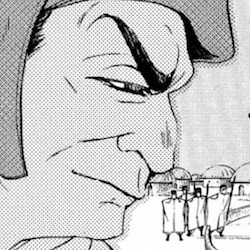
lol I. Sort of like this weird expression.

Iskander are you okay. What is with those eyes are you looking up or something...? I do like those claws though, very sharp and deadly. Can you imagine those coming for your face at full speed?
Also, Mahmut here is just. Cute. And Turkish interior design (or at least this world’s Turkish interior design) continues to confuse me. What. Where is the floor. What is a couch/bed and what is not.
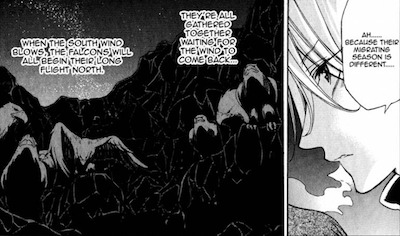
Oh, ok, at first I thought those eagles on the cliffs were people coming to attack the town or something. Phew.
Actually, it’s nighttime. They really can’t fly around at night (irl, for this manga narrative-wise unless you want to restrict Iskander to only being present during the day, this had to change).
Almost forgot to mention: pensive Mahmut here. His eye was also drawn very prettily here.

In exchange for the unrealistic part about eagles flying around at night, we get this neat bit of realism - Mahmut can’t call upon other eagles to help during the summer and autumn months. I like that restriction. It makes sense, rather than let him call up some birdy friends whenever and wherever possible.
His expression is a bit lopsided here, I guess it’s half fondness and half ‘it’s a pity’ sort of thing.

Look, I sympathize, I would totally be that person, too.
Unimpressed, ‘ugh’ Mahmut.
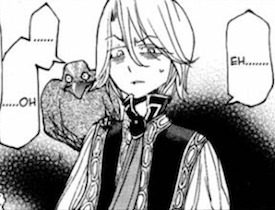
WELL, that was a sudden introduction, I guess they really trust that those pyramis charms won’t fall into the wrong hands and the people who use them are the intended holders...?
lol Mahmut. What’s with your face. Iskander is better, though. His expression is kind of, how you tell what Mahmut is thinking here. Though Mahmut looks sort of disgusted, unimpressed, there’s probably still shock in there.

I like the cup.

I wonder if it pained him to say that, as if he is Zaganos’s underling. Well, his rank is far lower now, but it’s not like he’s one of Zaganos’s men. Not sure what the fine details at work are, since I don’t have the raws.

lol this sounds like a game. just like a game.
This guy is very dramatic, though. Why did you not bother warning Mahmut what the other spy is like.

“Huh?” expression? He looks younger here again, haha.

I’m extremely curious about what sort of person Zaganos is, actually, but I’ve been told his story comes in drips and drabs across the whole series.
Mahmut’s face tends to look really cute in the manga. At certain points, he appears less adult than he does in the anime, which is quite hilarious seeing as I complained about the anime portraying him as childish before portraying him as a badass general/serious guy.
omg I love how even Iskander’s feathers are blowing in the last panel. Not sure how much force it would take to actually ruffle a bird’s feathers like that, come to think of it...the tend to lay flat, except maybe the fluffy chest feathers of some birds (I spent my childhood watching animal planet and the discovery channel ok).

U-UM. EXCUSE ME. MR. AWESOME. You really should get that cloak fixed, or maybe invest in a new one.
But UH. LOOK. HOW BIG. HIS BIRDY IS. (I was actually informed way back in the first chapter or so that falconers with female eagles would make an appearance, but holy this is a great entrance.)
I will be freaking about who this guy actually is a little further down, so I’ll talk about his birdy Katerina here.
Starting this series, I instantly liked Mahmut because he’s a falconer and that’s awesome. But I was 100% prepared for the series to forget about the sexual dimorphism between male and female birds of prey, it happens in most media. (females are almost always larger, and usually by a great deal, but in most media there is no size difference or the relationship is inverted)
I was glad Mahmut got Iskander, a male bird, because Mahmut is tiny (about 5′4″ officially I think). A smaller bird suits him better. Female golden eagles are 8-15 lbs and males are 6-10 lbs, it just makes sense that he doesn’t have 15 lbs of bird to tote around.
Imagine my surprise when I was told that someone does have a female golden eagle in the manga, and she is appropriately larger than Iskander.
I’m just. in love. with this manga.

Dramatic shading is A+ here.
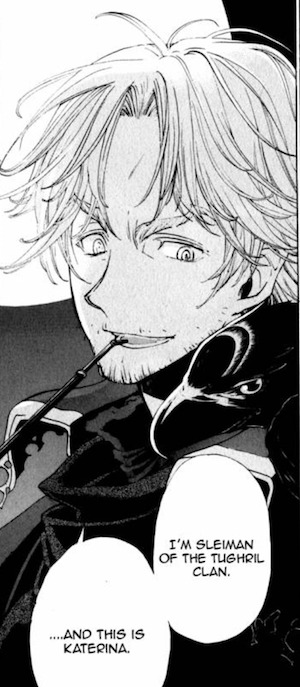
I think there is another spelling of his name out there, but I forgot what it was.
But HEY YOU. So there were other people from Mahmut’s clan that survived, probably whoever wasn’t in the village at the time. Come to think of it, did the manga ever mention Mahmut was the last of his clan? I don’t think so. Everyone from his village was wiped out, but that doesn’t mean everyone in the clan is dead. aha, take that ‘last of your kind’ trope
(btw I like his rugged look)

aw
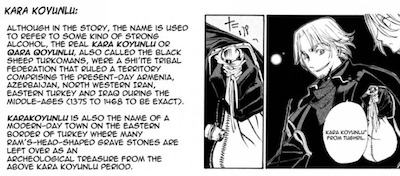
This was sort of confusing, so I’ll leave the notes here.
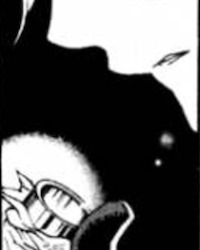
Perhaps a mix of uncertainty and something else here. I wouldn’t say sad or anything, but it’s a bit troubled.

oh man. xD I wonder if he ever tasted it before, he was young when he left. I mean, he probably drinks at this age given the time period, but I guess nothing quite so strong.
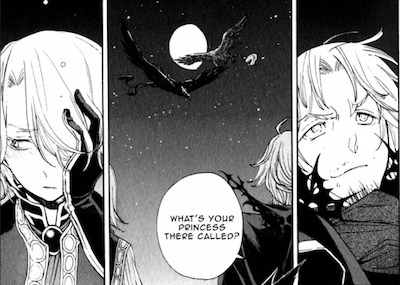
PRINCESS. oh my god. I’m dying. was. was that actually 姫 in the raw or something else? (I can think of one alternative, but I’d love it if it actually was. princess.)
That is both endearing and hilarious at the same time. I was going to stop watching the anime but. maybe I need to pick it up again. I love everyone’s voice except Mahmut’s so.
I need this to be in the anime. So I can tell what that term really is.
ANYWAY, BACK ON TRACK. Aw, I like the expressions in these panels. It’s just. I love the bonding over your respective birds. And someone who can understand his attachment to Iskander.
Also, Mahmut’s slightly embarrassed face lol. Is that little blush from the alcohol or embarrassment.
And I like the clear size difference between the birds.

The feathers look so good.
Also, Iskander is quite tiny like his owner, I mean, look at what this birds look like irl next to a person:

HUGE.

I’m. Just going to end up screen capping the whole chapter, aren’t I.
Aw, this whole part is just.
Is Mahmut a fast learner? He was only five when everyone died, that doesn’t leave much time to learn.

I like how he is clearly a younger man in this panel from 12 years ago. More clean-shaven.

THIS MANGA NEEDS TO STOP TEARING OUT MY HEART.
I wonder how large their clan was, actually.
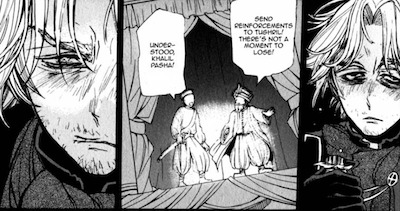
So, um, that’s why strong drinks don’t bother him. And I see the theatre continues to piss everyone off. How reliable.

Heey younger Zaganos. Still looks like your face is getting consumed by your hair, but he does actually look a bit younger, too. He’s quite young now, even, so. I forgot if his age was mentioned though.

I don’t really know this guy too well yet so it’s hard to tell, but man, that grief, rage, and helplessness. Perhaps that question “Why didn’t you save them!?” is directed at himself as much as it is to them.
The tone of this translation makes it hard to tell if he’s conflating the play with reality or if he’s just being snide (he’s being snide/contemptuous of course). But for a second there I was ???

This is heartbreaking, that’s what this is. And yeah, he does have survivor’s guilt.

Funnily enough, Zaganos’s physique here resembles Mahmut’s current one to me. He is a lot smaller/shorter 12 years ago (I just like how the adults actually age in this thing, ok. well, and Suleyman’s experience has aged him in a different way)

Oh, ok, he was 14. So he’s 26 now.
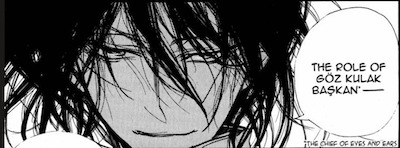
Must resist the urge to wonder what Zaganos’s story is because if I do it will be torture waiting for the pieces to unveil themselves.
But damn, and I thought his hair was eating his head before. I was wrong. He’s in 100% medusa mode now.

I was trying to steer clear of this train of thought, but Mahmut brings it up. The narrative (and Mahmut himself) are trying to compare him and Zaganos. They are/were similarly determined to do something for their country, but Zaganos actually knew how to do that, he was more pragmatic since he was young.
Which begs the question: what the heck happened in his past to make him that way? At this point, we don’t even know if he came from a wealthy background, if he had a normal life or a more tragic past like Mahmut, it’s all up in the air. And yet the narrative urges you to compare him to Mahmut when there is not much to go off of.
Which is, coincidentally, the same position Mahmut is in. He might know a little more about Zaganos than us readers, but it doesn’t matter. To him it feels like he’s going up against this huge force he cannot fathom until it hits him in the face, and we are similarly in the dark.
idk I like the way the narrative presents this, is all.

Gold.
“I take it you dislike Zaganos Pasha?”
“Of course not! ...a little...” His expression there is really scary, haha. I don’t even know what to make of it.
lol what’s with Iskander. Wait, is Iskander supposed to be “laughing” with Suleyman?

As if there wasn’t enough drama for one night.

Pwee is actually...a good way to describe how these birds sound. Go listen to the cry of a golden eagle. Poor things don’t exactly have the most majestic of cries.

I appreciate the very devilish face here.

LOOK. Look at how shocked Mahmut is. To be called something so familiar. (not sure what this would have been in the original...ugh I wanna know.)
OH WAIT. Is this lady the one who survived being attacked by the eagles and having a burning tent tossed on her?

I have way too many images in this post. But this is a looong chapter for some reason.
and these are very good, look how nice that shot from below is so you can see all the stars.
Katerina’s wingspan is MASSIVE (apparently it can reach a max of 7.5 feet so, like, it’s not like this is even an exaggeration)

This is actually a very nice bit of research. And true, as far as I know. I even found this fact from the San Diego Zoo/a research article on the species: “Red items excite golden eagles, as does the sight of blood; they will attack people wearing red.”

UH. THAT’S NOT GOOD. Also, kudos to the villain lady for actually doing research on the things she got attacked by last time.
Ok this post is getting way too long BUT know that I appreciate how the mangaka drew the blood splashed on him.

ONCE AGAIN. This is terrifying.
Extra terrifying because this is the end of the chapter. Mahmut, how will you get out of this now?? You’re about to become bird food.
← back・onward →
5 notes
·
View notes
Text
Mounts for an abdicated Erlking, Dogs, and Finding a bird for Alwin? And other Wild Huntish things...?
So...with Alwin having his own Wild Hunt and stuff...some thoughts came to mind. For one...tried to figure out if he should have a mount that is in some way different from the other huntsmen, Sir Bertilak (aka Bert, Bertie, or Laky (in an affection sense, not insulting sense) and Rosemary. After much consideration, I’m fairly certain the Mount of the Old Erlking will probably be a Unicorn. How he managed to tame a Unicorn I do not know. It might not be a living Unicorn but rather the manifestation of the existential echoes of a Unicorn present in a Unicorn Horn Alwin found (on that note, what if Unicorn Horns just...fell off after so many centuries like A Deer’s Antlers? Or maybe he found one of a dead Unicorn). So that when he isn’t riding it, the rest of it save the horn vanishes elsewhere and the horn is left for Alwin to use as a Cane (as all his fellows have some sort of Cane, Staff, Walking stick. For the Aesthetic and what not). Given he hunts and stuff...he probably has some large a Faerie Hounds similar to those of Gwyn Ap Nudd or....I forget how to spell the other guy’s name. Arwan? He’s Welsh? Anyway, Dogs. Two of his own. I then remembered Birds have been used in Hunting...come to the conclusion of..why not? But I’m not sure what sort of bird. I mean...I could go with a Falcon or Eagle or some such...but something seems off. I might go with an Owl. Owl’s are birds of Prey and what not...but what sort of Owl. Barn? Snowy? I’m leaning towards something like say the Eurasian Eagle Owl (mostly due to the intimidation of Eoastra’s Owl from The Chronicles of Ancient Darkness). Yeah...probably an Owl. I mean it might not be customary? But Alwin is an Eldritch entity older than time who once ruled over all Faeries and Elves and is left to amuse himself with Hunting and others sports, games, and tricks now that he has been made to step down from his rulership by his Fellows. The Owl might also be working for Alvis to assist in keeping an eye on Alwin. So yeah, a Unicorn, Dogs, and an Owl for the former Erl King Alwin V Eldritch. Now to think of names for said dogs and said Owl. Make of this what you will. Al, the Chronographing Cottager and Prince of Naming.
#My writing#The Wild Hunt#Alwin V Eldritch#FoE#the FoE#Faerie and Elfphame#Hunting Dogs#Hunting Birds#Owls#Fellowship of Eldritchicians#Eldritch Fellows#the Eldritch Brotherhood?#The Fellowship of Eldritchicians#Make of this what you will
0 notes
Photo

New Post has been published on http://adventurewithryan.com/2017/09/07/mount-rainier-national-park-washington-state-u-s-a/
Mount Rainier National Park, Washington State, U.S.A.

Today I wish I hiking Mount Rainier insteas of being stuck 45 floors up in the finacial district of NYC.
Mount Rainier National park is located about 50 miles South-East of Seattle, Washington. It is located on the most North-Western corner of the United States on the Pacific Ocean, excluding Alaska. Mount Rainier is the 5th oldest National Park in the United States of America. The park is over 225,000 acres large and includes the monstrous 14,411 foot (4,392M) active Mount Rainier Volcano, in which the park is named after. Within the National park there are valleys, waterfalls, meadows, old-growth forests, and more than 25 glaciers (including the largest in the United States outside of Alaska). As I went over yesterday, I am debating with myself on moving to Seattle for a year before I start my world-travel business. While I am in Seattle, I will definitely be exploring Mount Rainier National Park on multiple occasions.
The climate in the Seattle area is pretty consistent year round. Due to its unique geographical location with the weather streams, extreme heat waves are rare as well as very cold temperatures. During winter months, temperature averages from 36-45 degrees Fahrenheit, and during the summer month’s temperatures average from 56-76 degrees. However, this weather can completely change once you head inside the National Park. Once you begin gaining elevation in the National Park, temperatures begin to change. The average during the summer months is in the range of 42-63 degrees Fahrenheit (6-17 Celsius) but can reach into the 90’s(F) at some points. The average during the winter months ranges from around 20-34 degrees Fahrenheit (-5-1.5 Celsius) and can hit extreme lows into the teens (-15F for example).
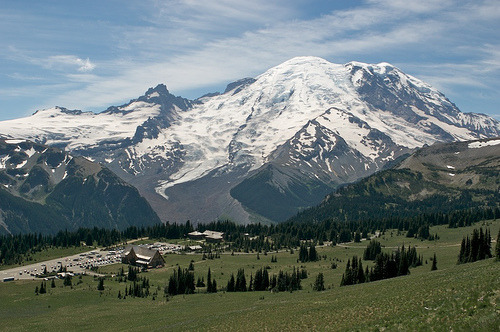
How to get there: Depending on which part of the park you want to explore that day, your entrance and your route will change. The two main roads that get you to the park from Seattle are route 165 (North-west entrance) and route 7 (turns into 706) coming into the South-west entrance. They take about the same time to get to. There are roads that travel through the central parts of the park, however do realize that it is still a national park, and you must park then hike to get to most sections worth exploring. Please use GPS to navigate based off of your preference.. The United States has almost all roads in the country mapped out at this point.. Use it to your advantage.
Wildlife: Mammals that inhabit this national park are especially the cougar (mountain lion), black bear, raccoon, coyote, bobcat, snowshoe hare, weasel, mole, beaver, red fox, porcupine, skunk, marmot, deer, marten, shrew, pica, elk, and mountain goat. The mountain goat is one of the iconic animals in this park and are only commonly found when you travel above 2,000 Ft. in elevation and is most commonly found above 5,000Ft. in elevation. Refer to here for more information on where to see mountain goats in Mount Rainier. The common birds of this park including raptors are the thrush, chickadee, kinglet, northern goshawk, willow flycatcher, spotted owl, steller’s jay, Clark’s nutcracker, bald eagle, ptarmigan, harlequin duck, grouse, peregrine falcon, gray jay, golden eagle, grosbeak and finch. Bird watching for large birds-of-prey can be very rich and rewarding if you plan your trip for the Spring – early Summer months.
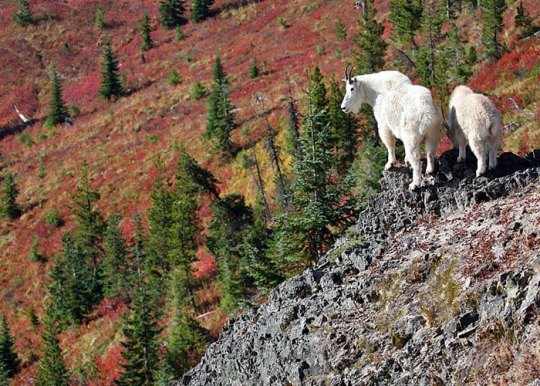
What to do while here: What brings the majority of people to this park every year is mainly hiking, site seeing, photography, snow skiing in the winter, bird watching, and climbing the Mount Rainier Volcano itself. There are hundreds of hiking trails all throughout the park. Paradise is the most popular destination in the park. There is a historic Inn located in this region of the park as well as dozens of famous hiking trails including the Skyline trail. Paradise is known as the snowiest place on Earth, reaching over 1,000 inches annually. Longmire is another popular destination in the park due to having 178 total campsites throughout the area as well as having its own visitor center. This is the main starting points for many people as well as the famous Wonderland hiking trail. For more hiking try heading over to the Sunrise area of Mount Rainier National Park. From here you hike the Mount Fremont, Burroughs Mountain and Sourdough Ridge trails, as well as visit some iconic meadows in the Springtime, and get to view the Emmons Glacier. For snow skiing in this area, the Mount Baker Ski Area is where I was told everybody goes near Mount Rainier National Park due to its insane annual snowfall of over 1,000 inches. (closest ski resort to Mount Rainier).

Hiking the Mount Rainier Volcano: Over 10,000 attempts are made to hike / climb to the top of Mount Rainier every year. There is only a 50% success rate of actually reaching the peak who individuals who attempt the climb. Most of the lack of success is due to weather patterns as well as lack of physical condition for underestimating the climb. The hike will take approximately 2-3 days to reach the peak depending on how fast you can climb. There are campgrounds located throughout the climb and if you pass the high camps, they require you to purchase a climbing pass and register (mainly to keep track of individuals who may not make it back). FYI Climbing teams require experience in glacier travel, self-rescue, and wilderness travel so DO NOT under-estimate this climb.

Recommendations: For all smaller sized National Parks (Under 250,000 acres) I recommend 4 days and 3 nights while staying within the park at either a local campground or on your own via tent or camper if allowed by the park. 1 night in this park must 100% be spent climbing to Camp Muir. This is the highest non-technical point (10,080FT) in the state of Washington and most of the United States. This hike is over 8 miles round trip, and includes 4,660ft. of elevation and has the most rewarding of views. The next two days I would spend exploring Paradise as well as the Sunrise regions of the park. My recommendation is to stay within Longmire region and maybe start with a warm-up hike every morning as this is one of the easier hiking areas. Spend the nights enjoying the night-skies and having campfires while drinking beer; after all isn’t this why you came here?! Spend the 4th day filling your time with anything you and your accompanied persons want to do.
If anyone has ever been to Seattle or lives(d) in Seattle, please leave any tips or information!
Thank you for reading. Please like, share and subscribe for more daily places in the world that I am currently dreaming of being at rather than work.
#blog#blogger#exploring#Hike#Hiking#National Park#National Parks#nationalparks#Nature#Outdoors#Seattle#travel#traveling#usa#west coast#world traveler
0 notes